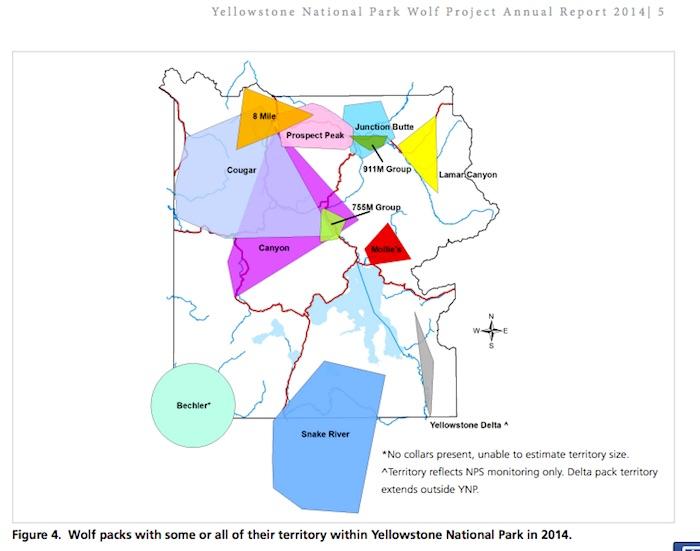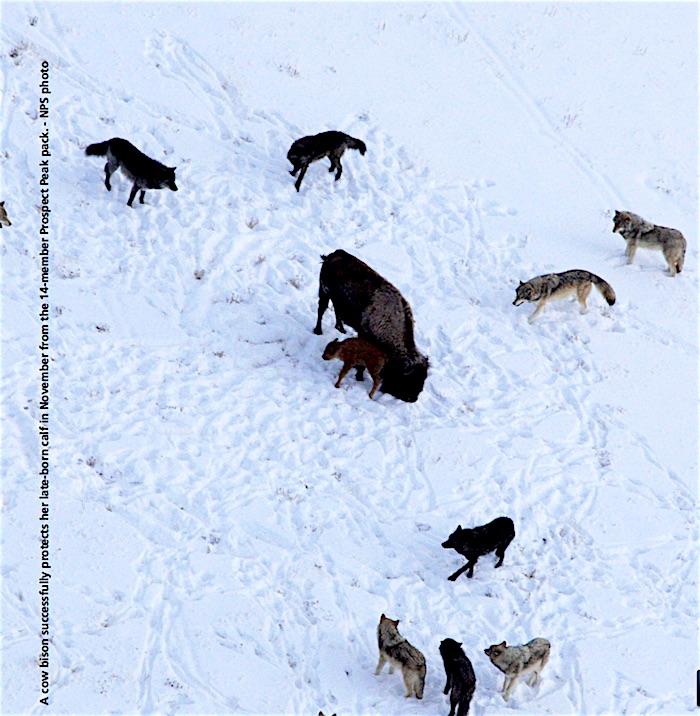
Twenty years after wolves were returned to Yellowstone National Park, the apex predators have carved territories out of most of the park, are maintaining a population around 100 animals, and are healthy, according to the park's latest report on the canines.
From the Eight Mile, Prospect Peak, and Junction Butte packs along the northern range, the Mollies Pack in the Pelican Valley, down to the Snake River and Bechler packs the wolves seem to have found suitable habitat to sustain packs of varying sizes. The largest were both the Snake River and Prospect Peak packs, which had 14 individuals at the end of 2014, according to the report released recently from Yellowstone's Center for Resources. The smallest pack was the 911M group, which had just two adults that roamed the Specimen Ridge, Tower, and Mount Washburn areas of the park.
Overall, there were 104 wolves in 11 packs at the end of 2014, a far cry from the 180 wolves counted in 2003 but within the 83-104 range counted each year from 2009-2014.
While mange and distemper have been pointed to by wildlife biologists for declines in the park's wolf population in past years, in 2014 neither was a signifcant factor, the report said.
Wolves frequently are seen by visitors throughout the park. They are up to three feet tall, and weighing from 80 to 110 pounds. They can live up to 11 years in the wild, but on average only last 3 to 4 years, and prey on hoofed animals, primarily elk.
The reports states that there are nine breeding pairs, as of December 2014, and 44 pups were still alive at the end of 2014. The size of the wolf packs, for the first time, was estimated using genetic sampling of scat samples at their dens.
There were a number of interesting points in the report, including the death of a collared wolf in an avalanche, a fairly unusual occurrence. Four other radio-collared animals also died in 2014; two killed by hunters outside the park's boundary. Another young pup was killed by researchers handling it, and the last fatality was from another wolf killing within its species. About 22 percent of the park's wolves wear radio collars.




Comments
The wolves have made no positive contribution to Yellowstone's ecosystem except for tourism thaqt hopes to see a wolf. There are much fewer moose in the system and the elk population remains constant. I've worked in Grand Teton Park for 13 seasons since 2003. I used to see moose every week iin the early years when there were few if any wolves. The past few years when wolves have become more abundant, I rarely if ever see a moose all season except in areas where ther are lots of humans. The wolves don't like to be around humans, so far. The elk viewing is not as good either, but the wolves have not been as devasting to elk as they have been to moose. So, what good are the wolves? No, good to me or others that love to see moose. I wish the wolves would all go away. I am pulling for mange or some other disease to wipe them out of the Yellowstone ecosystem. The wolf reintroduction was another stupid Federal program that the local folks in Wyoming despise.
What a bunch of garbage. Bill, if you did just a little research you will see that the introduction of wolves has helped just about every animal in Yellowstone. In fact, willows (a favorite food of moose) has recovered since the reintroduction of wolves. While it is true that wolves do take a moose now and again (3 confirmed in 2014) it is the coyote that has benefited least from wolf introduction. Beaver, pronghorn, bears, raptors, etc have all benefited. There is article after article backing this up. I love moose too but their decline in numbers cannot be attributed to the wolves. The wolf reintroduction in YNP is one of the most successful wildlife projects ever. Period.
Bill--If you don't see them, they are acting like moose ought to act. And diversity is the sign of a healthy ecosystem, and wolves are part of that diversity.
apparently you missed the PBS show that shows all the positive changes that have come to Yellowstone since wolves were reintroduce.
Jon,
You mean the one with the Brit that calls elk "deer". Yeah, that was a real scientific investigation. I don't know if the wolfs are good or bad but it is the reliance on such pseudo science that taints much of the "environmental" crowd.
Curious about the actual moose population in the Grand Tetons so I did a quick search and came up with this:
http://www.jhnewsandguide.com/news/environmental/north-teton-wolves-zero...
No question overall moose numbers have significantly decreased. But apparently several other factors are involved besides wolves.
I didn't find more recent numbers. Maybe someone could post a few links to better sources.
I live in southern MI and a trip to Yellowstone and Grand Teton NPs is a big deal for my wife and I. Love seeing all the wildlife. We've been there several times and seen bears (griizzlies and black), moose, great grey owls and of course all the other big stuff. We certainly don't agree with wolf elimination.
More recent info on Yellowstone's moose population from the Traveler archives:
http://www.nationalparkstraveler.com/2014/04/husband-wife-team-studying-...